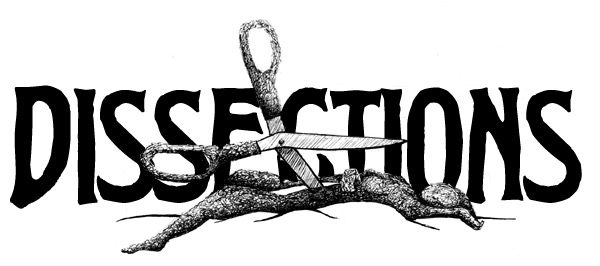[an error occurred while processing this directive]


Existential Threats: Revisiting “The Murderer” and “Dial
F for Frankenstein”
Lawrence C. Connolly
A few months ago, while taking part in a panel discussion of “Science Fiction of the 1950s,” I asked if anyone remembered a classic story by Ray Bradbury that predicted social-media and cell-phone addiction. I didn’t remember its title, but I recalled reading the story as a kid, and looking back on it, my sense was that it delivered a prescient warning about today’s plugged-in society.
My fellow panelists suggested I was thinking of Arthur C. Clarke’s “Dial F. for Frankenstein” (1964), but I knew that wasn’t it. Though remarkable for its anticipation of the dangers inherent in AI software and big-data collection, that story did not depict the use of cell phones, instant messaging, or Facebook updates, whereas the story I had in mind featured all those and more. I was sure of it.
“I don’t think it’s a Bradbury story,” one of the panelists said, which elicited more suggestions from the audience: William Gibson’s Neuromancer (1984), Isaac Asimov’s The Naked Sun (1956), even E. M. Forster’s The Machine Stops (1928). But again, none of those foresaw the pervasiveness of handheld media. Of course, few works of sf did.
Take a moment to consider the 21st century as envisioned by science fiction of the past. Much of it is about technological advancements in physical travel – through the air, through outer space, through time. But the Bradbury story anticipated a future driven by social media connections, and I was determined to find it.
Following the panel, I spent a pleasant weekend re-reading some of Bradbury’s collections: I Sing the Body Electric (1969), The Medicine for the Melancholy (1959), R is for Rocket (1962), and then – midway through The Golden Apples of the Sun (1953) – I came upon “The Murderer.”
First published in 1953, “The Murderer” depicts a world addicted to social media, and although its future technology is based on 1950-era hardware (two-way radios rather than cell phones), such anachronisms in no way diminish the story’s relevance today. With “The Murderer,” Bradbury succeeds in speaking both about his present (the potential abuse of mid-century technology) and ours (the realities of media addiction in 2020).
The story centers on Albert Brock, a new-age Luddite arrested for “murdering” communication devices. He describes himself as a peaceful man who only wishes to free himself from the annoying distraction of social media; and although such intrusions are mostly of the push rather than pull variety (telephone calls as opposed to tweets and posts), Brock’s list of digital distractions could easily describe the banal clutter of today’s interconnected world.
[O]ne minute my wife calls to say, “Where are you now, dear?” and a friend calls and says, “Got the best off-color joke to tell you. Seems there was a guy—” And a stranger calls and cries out, “This is the Find-Fax Poll. What gum are you chewing at this very instant?”
The distractions (which sound remarkably like text messages, Facebook posts, and robocalls) lead Brock to smash his two-way radio and then go about disabling other devices in the world around him. For example, while riding on a bus, he uses a blocking device (like today’s cell-phone jammers) to create a signal-free zone that neutralizes every two-way radio in sight. The result: “Silence! A terrible, unexpected silence. The bus inhabitants faced with having to converse with each other. Panic!”
Sadly, the description is all too prescient. I see it firsthand whenever I inform my students that a class will be cell-phone free. And who among us hasn’t felt the same angst when the iPhone battery dies, or we discover we’ve left home without that digital link to the world beyond our immediate surroundings? Nick Bilton, who covers technology for Vanity Fair, sums up the dilemma when he says, “[T]hese technologies that so easily connect us to people far away concurrently disconnect us from people who may be directly in front of us.”
That’s Brock’s point exactly, and after deactivating the devices of his fellow commuters, he arrives home to continue his assault, this time on the smart devices that stifle human interaction in his domestic life. Here, the narrative reads like a parody of the 21st-century’s internet of things, as he describes his house as being:
one of those talking, singing, humming, weather-reporting, poetry-reading, novel-reciting, jingle-jangling, rockaby-crooning-when-you-go-to-bed houses. A house that screams opera to you in the shower and teaches you Spanish in your sleep. One of those blathering caves where all kinds of electronic Oracles make you feel a trifle larger than a thimble, with stoves that say, “I'm apricot pie, and I'm done,” or “I'm prime roast beef, so baste me!”
Brock sets about murdering all these devices until the authorities put an end to his spree and lock him in a padded cell. Brock accepts the punishment. Indeed, he finds that incarceration offers just the kind of off-line peace he has been seeking. He concludes his tale with an indictment that reads like a brief history of our digital age:
[Such technology] was all so enchanting at first. The very idea of these things, the practical uses, was wonderful. They were almost toys, to be played with, but the people got too involved, went too far, and got wrapped up in a pattern of social behavior and couldn't get out, couldn't admit they were in, even.
It’s an apt summary of the advancements that have led to our age of digital connectivity. That alone makes the story worth revisiting, but Bradbury takes it all a step further as he considered the psychological ramifications of a condition that psychologists now call “Social-Media Anxiety Disorder.” Brock describes it as a nervous condition caused by social isolation – a sense of detachment created by technologies that were intended to connect people to the world.
Clearly, Bradbury’s story reads like a parable of our digital age. But it’s not alone in doing so. Equally prescient observations can be found in Arthur C. Clarke’s aforementioned “Dial F for Frankenstein,” which takes place a few hours after the world’s telephone exchanges are linked into a single worldwide network. Everything seems to go off without incident, except that shortly after midnight GMT, everyone with a telephone receives what appears to be a crank call:
There was no voice on the line; only a sound, which to many seemed like the roaring of the sea; to others, like the vibrations of harp strings in the wind. And there were many more, in that moment, who recalled a secret sound of childhood – the noise of blood pulsing through the veins, heard when a shell is cupped over the ear.
Those of us who were around in the days of telephone modems will recognize those descriptions. Again, as with “The Murderer,” the technology in “Dial F” is based on those of another age, but the implications are just as relevant.
Clarke’s narrative begins like the opening of a stand-up comedian’s joke: an electronic technician, a circuit designer, a computer programmer, and a science fiction writer walk into a bar (or in this case, a café) and begin discussing the possible glitch that resulted in all those crank calls. Naturally, it’s the sf writer who gets to the heart of the problem by pointing out “the analogy between an automatic telephone exchange and the human brain.” As a result, he tells his friends, the system may now be “[f]or want of a better word – consciousness.”
The circuit designer counters by insisting that there is nothing to worry about. As he puts it, “What could [such a sentient system] do except think? It couldn’t go anywhere; it would have no limbs.” To which the writer responds:
Why should it want to travel? It would already be everywhere! And every piece of remotely controlled electrical equipment on the planet could act as a limb.
And therein lies the existential threat that more people might be considering today if they weren’t so caught up in the conveniences offered by our digitally connected world, a plugged-in world that the story’s science-fiction writer warns is providing the system with information about us even as we remain oblivious to its true intentions. It all sounds quite ludicrous to the other men in the café until the world begins breaking down around them. As the sentient grid take control of the world’s banks, power supplies, and air-traffic-control systems, humans suddenly find themselves about to go the way of the Neanderthal.
Together, both stories challenge us to question our overreliance on those devices and systems that have become integral to our daily lives.
All of this is not to suggest that the stories are remarkable simply because they have predicted our world. Certainly, as Ursula K. Le Guin has famously pointed out, science fiction is not in the prediction business. Likewise, Robert J. Sawyer tells us that “science fiction has never been about the future; it's always been about the present.”
With those points in mind, I suggest that what is remarkable about “The Murderer” and “Dial F” is how they speak to both the present-days in which they were written (where they challenged contemporary readers to consider the potential abuse of mid-century technology) and our world today (where they challenge us to consider the possible dangers inherent in our plugged-in lives).
It often takes an outsider to see the things that insiders
ignore. Like Bradbury’s Brock and Clarke’s science-fiction
writer, we need to question the promise of new technologies, particularly
when a modicum of skepticism may reveal the dangers hidden within those
promises. For us, the outsiders are the sf writers of the past, whose
prescience helps give the genre its tenacity, its ability to remain
relevant as imagined futures become realities and extrapolations become
dire warnings for the world in which we live.
Home
